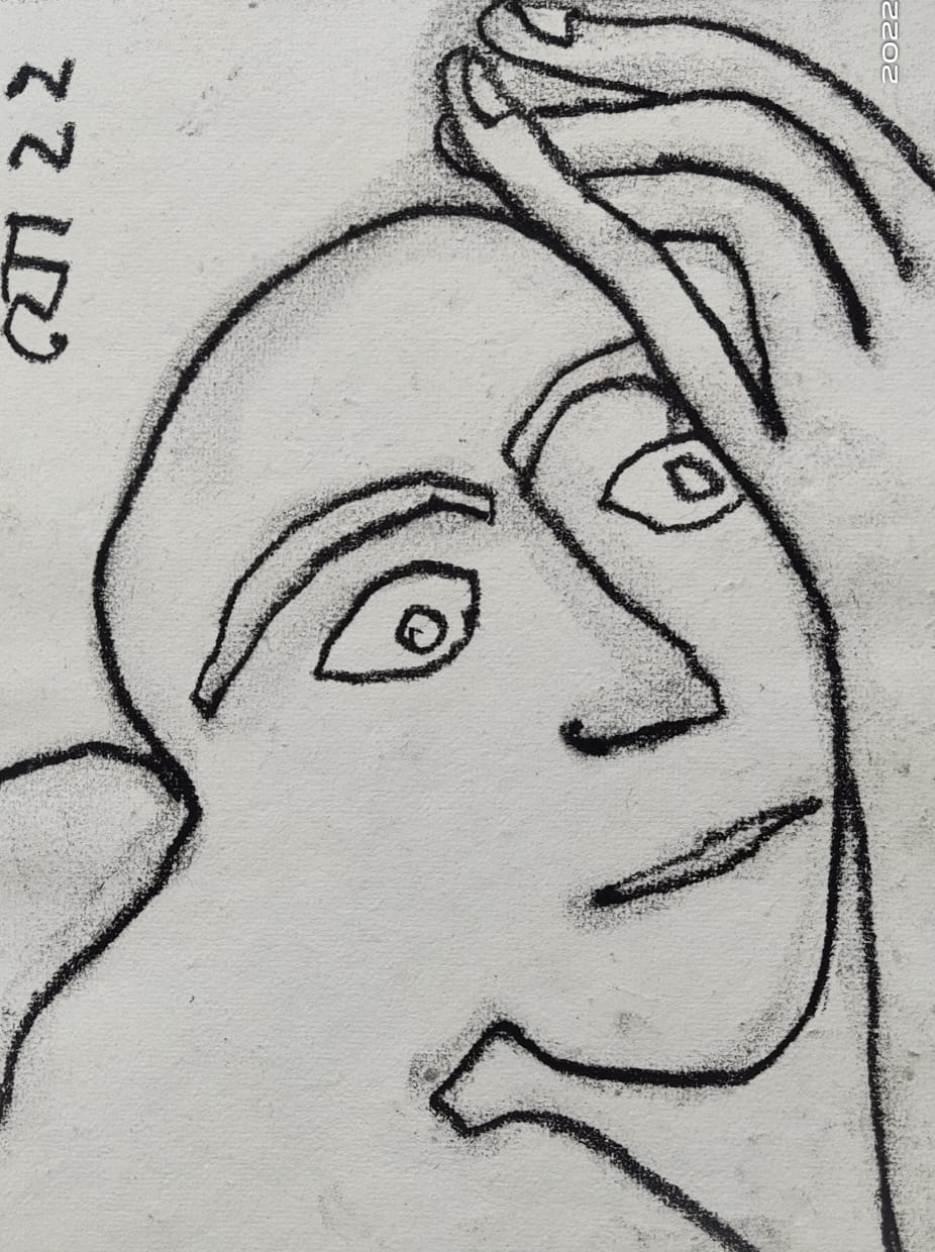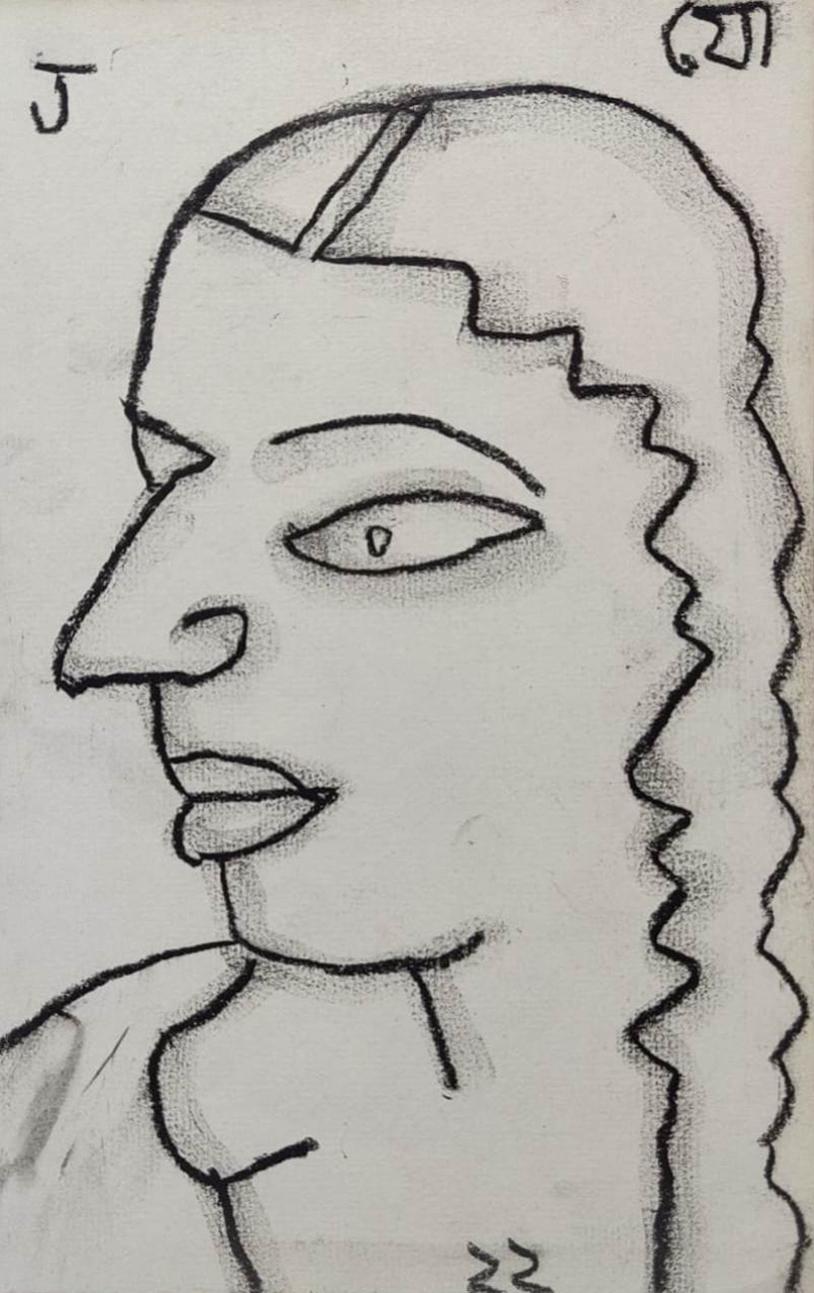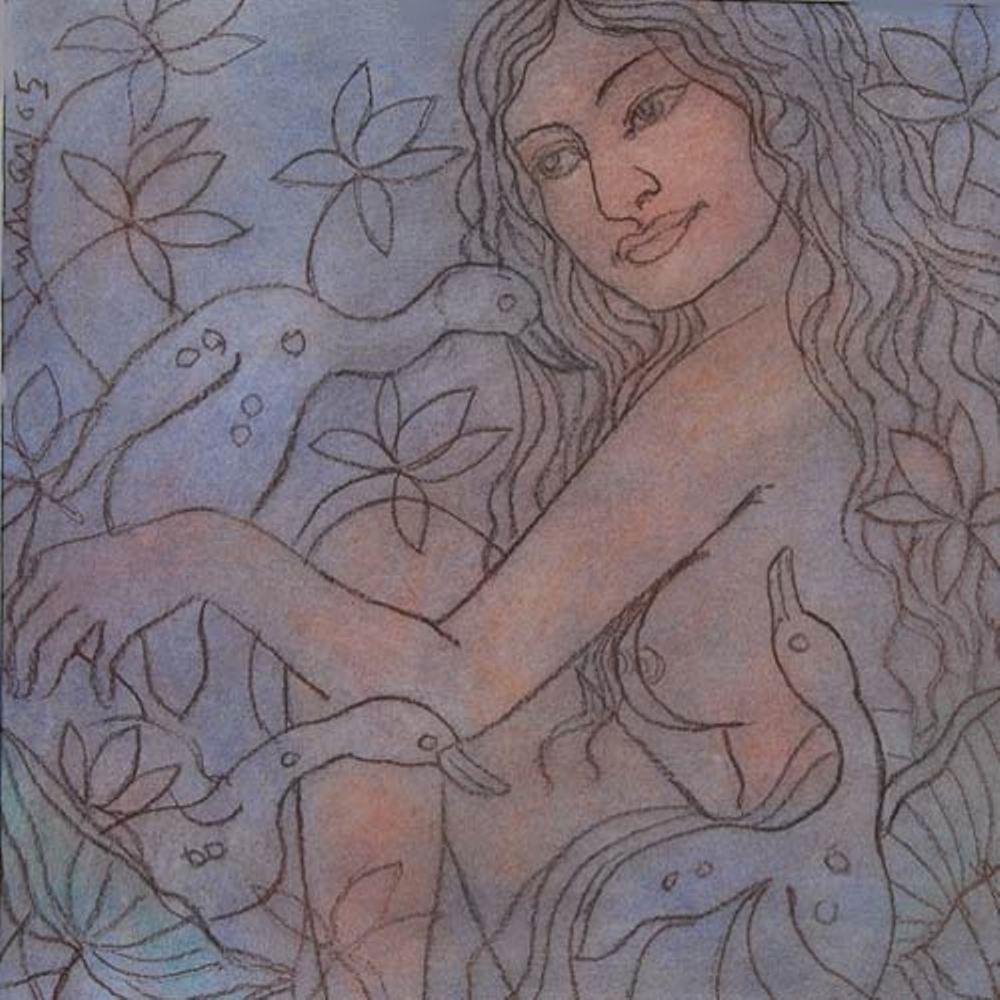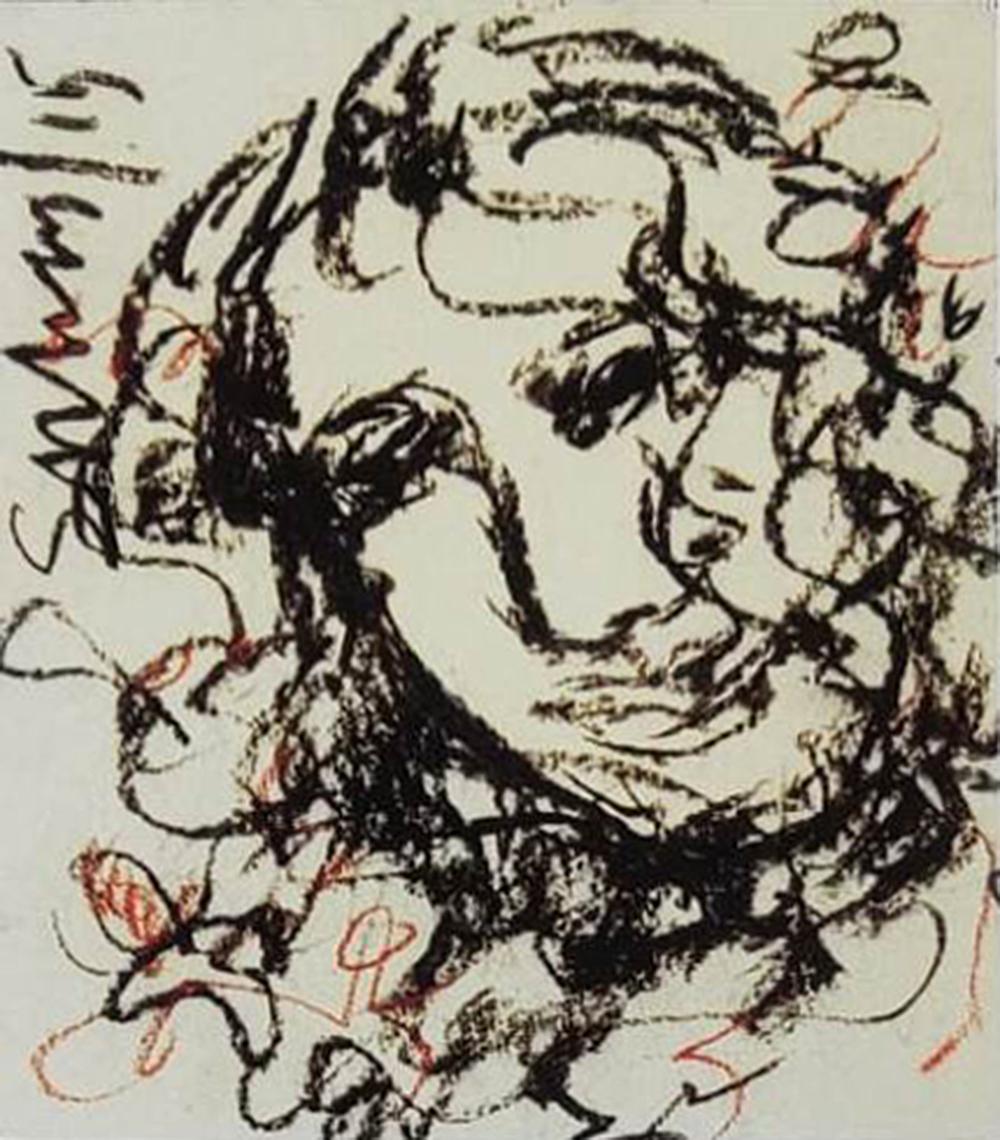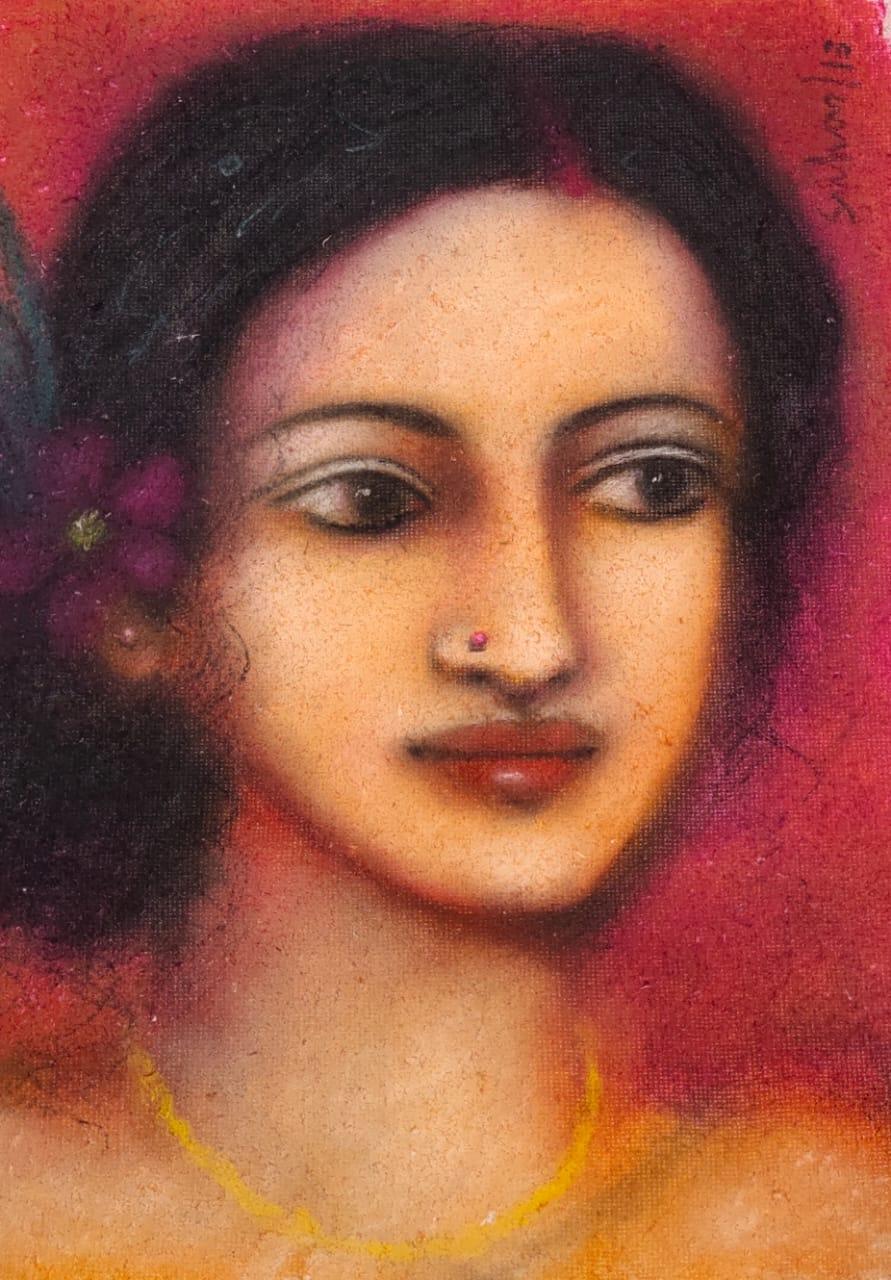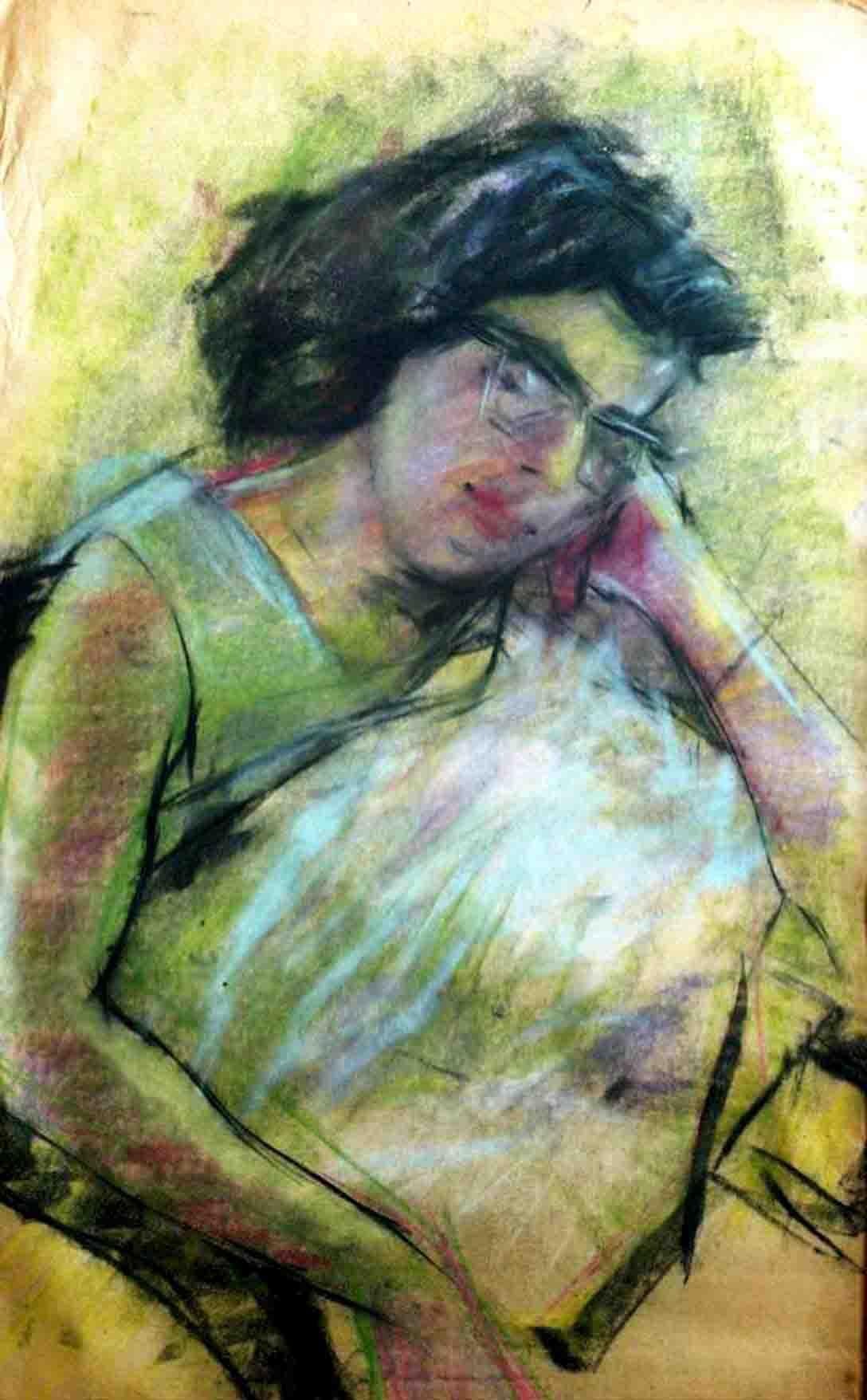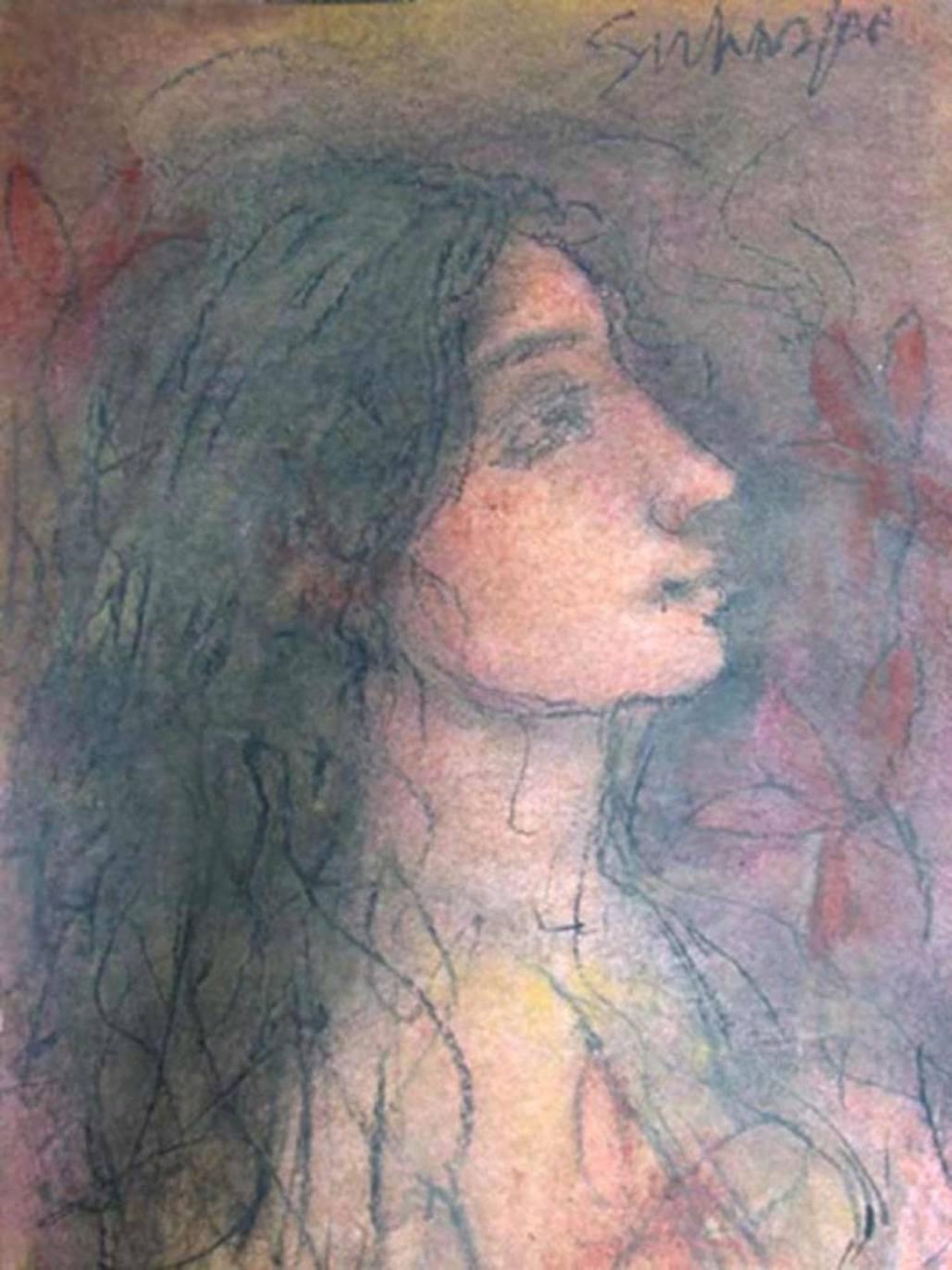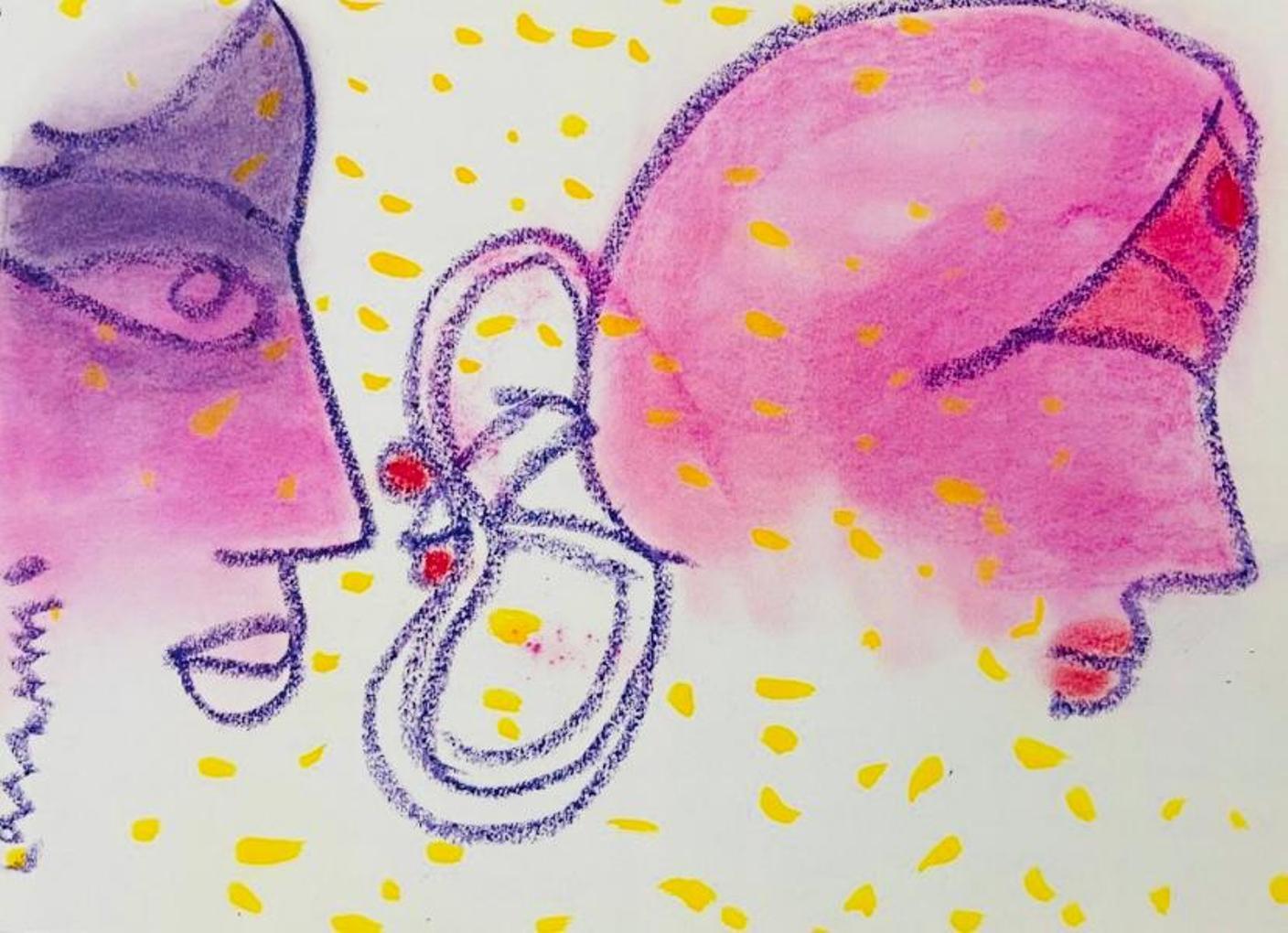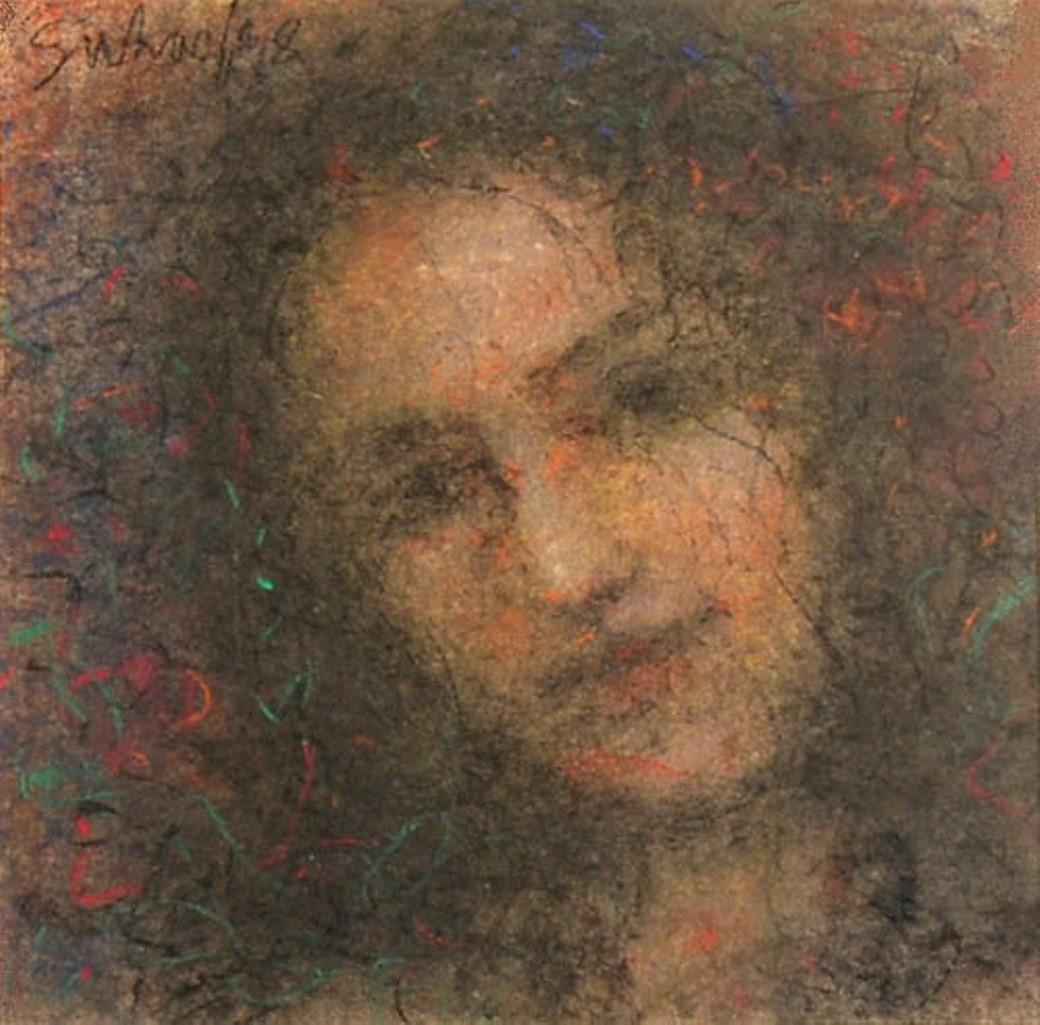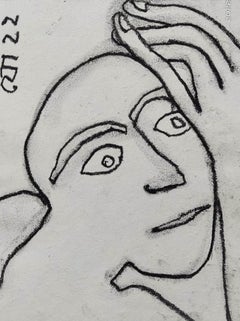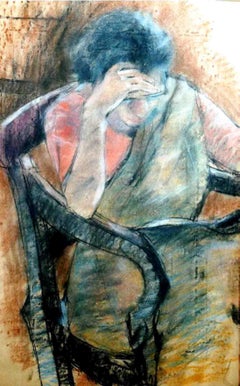
Women sitting in a Chair, Pastel on paper, Painting, Blue, Red, Brown"In Stock"
View Similar Items
Want more images or videos?
Request additional images or videos from the seller
1 of 8
Bikash BhattacharjeeWomen sitting in a Chair, Pastel on paper, Painting, Blue, Red, Brown"In Stock"1962
1962
About the Item
About the Seller
4.9
Vetted Seller
These experienced sellers undergo a comprehensive evaluation by our team of in-house experts.
Established in 2004
1stDibs seller since 2017
119 sales on 1stDibs
Typical response time: 23 hours
More From This SellerView All
- Sleepless Night, Dry Pastel on Paper by Artist Jogen Chowdhury "In StockBy Jogen ChowdhuryLocated in Kolkata, West BengalJogen Chowdhury Sleepless Night, Dry Pastel on Paper 7 x 9.25 inches , 2022 The work will be shipped inclusive of framing. Signed in Bengali Style : He has immense contribution in inspiring young artists of India. Jogen Chowdhury had developed his individual style after his return from Paris. His most famous paintings are in ink, watercolor and pastel. He has painted in oil medium as well. In Chowdhury’s more recent works the sensory experiences of cloth, bolsters, sofas and the human body are cross-projected to produce an uncanny world of tran-substantiated tumescence and flaccidness. Jogen Chowdhury has been widely acknowledged to be, the master of the unbroken line. Like Léger, Chowdhury has been stirred by the linear Kalighat pat tradition, but his lines are emotive and used to express and suggest the character of a person. This is done by, distorting the form without breaking the line and in the world of young, contemporary art; distortion has been Jogen Chowdhury’s most significant impact. Perhaps, because of this, a common observation of his work is that his “people” are caricatures. The person feels familiar to the viewer but it is far more individualised – the face is imaginary but the psyche or characteristics are real. The power and beauty of his technique and line is this play between the known and unknown. In Jogen Chowdhury’s work, the figure is always in the foreground, it is primary, it conveys everything. He uses colour to give volume to his figures and the fluidity of his lines bring a sensual aspect to his forms. About the Artist and his work : Born : Born 1939 in Daharpara Village, Faridpur, Bangladesh. Jogen Chowdhury is an eminent Indian painter and considered an important painter of 21st century India. Family Background : His father Pramatnath Chowdhury was a Brahmin zamindar. Both his parents took interest in art, Jogen Chowdhury’s father Pramatnath Chowdhury painted several mythological scenes from the village theatres and also sculpted various Hindu icons. Whereas his mother was an expert in Alpana drawings. 1939-47 Jogen Chowdhury lived in a village atmosphere. And after partition in 1948, the whole family shifted. Till 1951 the whole family stayed at the police department quarter of his uncle, where on the walls Jogen Chowdhury painted his first painting, 1962 Jogen Chowdhury was employed as Designer in the Handloom Board. Education : 1955-60: Studied at the Government College of Art and Crafts, Kolkata. 1965 : He went to paris to study in Ecole des Beaux Arts, in William Hayter’s Atelier 17. Professional Experience : 1968-72 : He worked as an Art-Designer, Madras Handloom Board, Madras. 1970 : A collection of his poems were published, titled ‘Hridoy Train Beje Othey’. 1987 : Joined Kala Bhavan , Santiniketan as a professor of painting. Selected Exhibitions : 1972, 1975 & 1978 respectively : I, III, IV Triennales at New Delhi. 1979: The Sao Paolo Biennale. 1980: The exhibitions at the Fukuoka Museum, Japan. 1982: The Royal Academy, London. 1982: The Hirschhorn Museum, Washington D.C. 1986: The II Havana Biennale. 1989: ‘Festival of India’, in Geneva. 2002: Saffron art...Category
2010s Modern Mixed Media
MaterialsPaper, Pastel, Mixed Media
- Woman Face with Braid Dry Pastel on Paper by Artist Jogen Chowdhury "In StockBy Jogen ChowdhuryLocated in Kolkata, West BengalJogen Chowdhury Woman Face with Braid, Dry Pastel on Paper 10 x 6.3 inches , 2022 ( this is the unframed size ) The work will be shipped inclusive of framing. Signed in Bengali Style : He has immense contribution in inspiring young artists of India. Jogen Chowdhury had developed his individual style after his return from Paris. His most famous paintings are in ink, watercolor and pastel. He has painted in oil medium as well. In Chowdhury’s more recent works the sensory experiences of cloth, bolsters, sofas and the human body are cross-projected to produce an uncanny world of tran-substantiated tumescence and flaccidness. Jogen Chowdhury has been widely acknowledged to be, the master of the unbroken line. Like Léger, Chowdhury has been stirred by the linear Kalighat pat tradition, but his lines are emotive and used to express and suggest the character of a person. This is done by, distorting the form without breaking the line and in the world of young, contemporary art; distortion has been Jogen Chowdhury’s most significant impact. Perhaps, because of this, a common observation of his work is that his “people” are caricatures. The person feels familiar to the viewer but it is far more individualised – the face is imaginary but the psyche or characteristics are real. The power and beauty of his technique and line is this play between the known and unknown. In Jogen Chowdhury’s work, the figure is always in the foreground, it is primary, it conveys everything. He uses colour to give volume to his figures and the fluidity of his lines bring a sensual aspect to his forms. About the Artist and his work : Born : Born 1939 in Daharpara Village, Faridpur, Bangladesh. Jogen Chowdhury is an eminent Indian painter and considered an important painter of 21st century India. Family Background : His father Pramatnath Chowdhury was a Brahmin zamindar. Both his parents took interest in art, Jogen Chowdhury’s father Pramatnath Chowdhury painted several mythological scenes from the village theatres and also sculpted various Hindu icons. Whereas his mother was an expert in Alpana drawings. 1939-47 Jogen Chowdhury lived in a village atmosphere. And after partition in 1948, the whole family shifted. Till 1951 the whole family stayed at the police department quarter of his uncle, where on the walls Jogen Chowdhury painted his first painting, 1962 Jogen Chowdhury was employed as Designer in the Handloom Board. Education : 1955-60: Studied at the Government College of Art and Crafts, Kolkata. 1965 : He went to paris to study in Ecole des Beaux Arts, in William Hayter’s Atelier 17. Professional Experience : 1968-72 : He worked as an Art-Designer, Madras Handloom Board, Madras. 1970 : A collection of his poems were published, titled ‘Hridoy Train Beje Othey’. 1987 : Joined Kala Bhavan , Santiniketan as a professor of painting. Selected Exhibitions : 1972, 1975 & 1978 respectively : I, III, IV Triennales at New Delhi. 1979: The Sao Paolo Biennale. 1980: The exhibitions at the Fukuoka Museum, Japan. 1982: The Royal Academy, London. 1982: The Hirschhorn Museum, Washington D.C. 1986: The II Havana Biennale. 1989: ‘Festival of India’, in Geneva. 2002: Saffron...Category
2010s Modern Mixed Media
MaterialsPastel, Mixed Media, Paper
- Radha, Tempera Coloured Conte on Pastel on Paper by Artist Suhas Roy "In Stock"By Suhas RoyLocated in Kolkata, West BengalSuhas Roy - Radha - 20 x 20 inches ( unframed size) Tempera Coloured Conte on Pastel on Paper , 2005 Suhas Roy 's mystic woman which he calls 'Radha', either Oil on canvas or sof...Category
Early 2000s Modern Figurative Paintings
MaterialsPaper, Conté, Tempera, Pastel, Board
- Radha, Figurative, Charcoal & Pastel by Master IndianArtist Suhas Roy "In Stock"By Suhas RoyLocated in Kolkata, West BengalSuhas Roy - Radha Charcoal on Paper , 11 x 15 inches , 2015 ( Unframed & Delivered ) Suhas Roy 's mystic woman which he calls 'Radha', either Oil on canvas or soft colored pastel on Paper or board are a series of work where he sees an ethereal mystic godlike and innocent spirit in every woman he meets. Style : He is one of the biggest and the most enduring names in the genre of Indian modern art. Often dubbed the father of female figurative forms. Radha Series and the Christ Series in soft pastel on paper and intense Oil on canvas paintings .Consequently, his recent body of works, "Drops of Silence", executed in oil, pastels and pen-and-ink etchings on backdrops in watercolours, are all studies of "mysterious slightly surreal nude women floating in a void". Roy's forte is Radhika - dark, enigmatic, beautiful Indian women with the slightest smile and ethereal in its quality . About the Artist & his work : Born : 1936, Bangladesh. Education : 1953-58 : Diploma in Painting, Indian College of Art and Draughtsmanship, Calcutta. 1956-66 : Studied graphic art under the guidance of S.W. Hayter, Atelier 17 and mural art at cole Superior Des Beaux Art, Paris. Exhibitions : His works have been exhibited all over the world through exhibitions like the Asian Graphic Prints Traveling Exhibition, USA, the Tokyo Print Biennale, Japan, Contemporary Indian Art...Category
2010s Modern Figurative Paintings
MaterialsPaper, Charcoal, Pastel
- Radha, Figurative, Mixed Media on Paper by Modern Artist Suhas Roy "In Stock"By Suhas RoyLocated in Kolkata, West BengalSuhas Roy - Radha Mixed Media on Paper , 12 x 16 inches , 2013 Framed to be 23 x 27 inches Shipment cost estimates : Unframed shipment : 150 USD Cost of Framed shipment to USA e...Category
2010s Modern Figurative Paintings
MaterialsPaper, Mixed Media, Charcoal, Oil Pastel, Pastel
$3,375 Sale Price28% Off - Lost in Thoughts, Pastel on Paper, Painting, Green, Black, Red "In Stock"By Bikash BhattacharjeeLocated in Kolkata, West BengalBikash Bhattacharjee - Lost in Thoughts - 36 x 22 inches (unframed size) Pastel on Paper , 1962 Inclusive of shipment in roll form. Style : Bikash Bhattacharya is credited with bringing realism back to Indian art at a time when artists in India were leaning more towards distortion of figures and abstraction. Besides painting the city and its people that he knew so well, Bhattacharjee was an accomplished portrait painter. Realism was Bhattacharjee’s forte; his oil paintings could depict the exact quality of drapery or the skin tone of a woman. He achieved mastery in capturing the quality of light. Bhattacharjee achieved an enigmatic quality in his paintings that works on many levels from the visual to the subconscious. Subject matter included depictions of the female form, and people of all ages and situations—old men and women, children, domestic help. He had the ability to create an authentic milieu as a background to the characters to heighten the drama. Bikash had been deeply influenced by the surrealists, and stated that Salvador Dalí was his favourite painter. About the Artist and his work : Bikash Bhattacharjee (1940 - 2006) was born in Kolkata. Education : At a very early age he lost his father. The consequent struggle for survival left him with a deep sense of insecurity as well as an empathy for the under-privileged, who often feature in his works. In 1963, he graduated with a Diploma in Fine Arts from Indian College of Art and Draftsmanship. Teaching Career : Bhattacharjee taught at Indian College of Art and Draftsmanship from 1968 to 1972. He taught at the Government College of Art & Craft, Kolkata from 1973 to 1982. In 1964, he became a member of the Society of Contemporary Artists. Solo Exhibition : His first solo exhibition was at Kolkata in 1965. Group Shows : 2016 – Dag Modern, New York, The Art of Bengal 2016 – Akara Art, Mumbai, Mysteries of the Organism 2015 – Dag Modern, New York, The Naked and the Nude: The Body in Indian Modern Art 2015 – Dag Modern, Mumbai, India Modern – Narratives from 20th Century Indian...Category
1960s Modern Figurative Paintings
MaterialsPaper, Pastel, Mixed Media
You May Also Like
- Portrait. Paper, pastel, 35.5x23 cmLocated in Riga, LVPortrait. Paper, pastel, 35.5x23 cm The composition focuses on portraying the facial features and characteristics of a man. The artist has employed a linear style, using bold and de...Category
20th Century Modern Figurative Paintings
MaterialsPastel, Paper
- Rare Modernist Hungarian Rabbi Pastel Drawing Gouache Painting Judaica Art DecoBy Hugó ScheiberLocated in Surfside, FLRabbi in the synagogue at prayer wearing tallit and tefillin. Hugó Scheiber (born 29 September 1873 in Budapest – died there 7 March 1950) was a Hungarian modernist painter. Hugo Scheiber was brought from Budapest to Vienna at the age of eight where his father worked as a sign painter for the Prater Theater. At fifteen, he returned with his family to Budapest and began working during the day to help support them and attending painting classes at the School of Design in the evening, where Henrik Papp was one of his teachers. He completed his studies in 1900. His work was at first in a post-Impressionistic style but from 1910 onward showed his increasing interest in German Expressionism and Futurism. This made it of little interest to the conservative Hungarian art establishment. However, in 1915 he met the great Italian avant-gardist Filippo Tommaso Marinetti and the two painters became close friends. Marinetti invited him to join the Futurist Movement. The uniquely modernist style that he developed was, however, closer to German Expressionism than to Futurism and eventually drifted toward an international art deco manner similar to Erté's. In 1919, he and his friend Béla Kádar held an exhibition at the Hevesy Salon in Vienna. It was a great success and at last caused the Budapest Art Museum to acquire some of Scheiber's drawings. Encouraged, Scheiber came back to live in Vienna in 1920. A turning point in Scheiber's career came a year later, when Herwarth Walden, founder of Germany's leading avant-garde periodical, Der Sturm, and of the Sturm Gallery in Berlin, became interested in Scheiber's work. Scheiber moved to Berlin in 1922, and his paintings soon appeared regularly in Walden's magazine and elsewhere. Exhibitions of his work followed in London, Rome, La Paz, and New York. Scheiber's move to Germany coincided with a significant exodus of Hungarian artists to Berlin, including Laszlo Moholy-Nagy and Sandor Bortnyik. There had been a major split in ideology among the Hungarian avant-garde. The Constructivist and leader of the Hungarian avantgarde, Lajos Kassák (painted by Hugó Scheiber in 1930) believed that art should relate to all the needs of contemporary humankind. Thus he refused to compromise the purity of his style to reflect the demands of either the ruling class or socialists and communists. The other camp believed that an artist should be a figurehead for social and political change. The fall out and factions that resulted from this politicisation resulted in most of the Hungarian avant gardists leaving Vienna for Berlin. Hungarian émigrés made up one of the largest minority groups in the German capital and the influx of their painters had a significant effect on Hungarian and international art. Another turning point of Scheiber's career came in 1926, with the New York exhibition of the Société Anonyme, organized by Katherine Dreier. Scheiber and other important avant garde artists from more than twenty-three countries were represented. In 1933, Scheiber was invited by Marinetti to participate in the great meeting of the Futurists held in Rome in late April 1933, Mostra Nazionale d’Arte Futurista where he was received with great enthusiasm. Gradually, the Hungarian artists began to return home, particularly with the rise of Nazism in Germany. Kádar went back from Berlin in about 1932 and Scheiber followed in 1934. He was then at the peak of his powers and had a special flair in depicting café and cabaret life in vivid colors, sturdily abstracted forms and spontaneous brush strokes. Scheiber depicted cosmopolitan modern life using stylized shapes and expressive colors. His preferred subjects were cabaret and street scenes, jazz musicians, flappers, and a series of self-portraits (usually with a cigar). his principal media being gouache and oil. He was a member of the prestigious New Society of Artists (KUT—Képzőművészek Új Társasága)and seems to have weathered Hungary's post–World War II transition to state-communism without difficulty. He continued to be well regarded, eventually even receiving the posthumous honor of having one of his images used for a Russian Soviet postage stamp (see image above). Hugó Scheiber died in Budapest in 1950. Paintings by Hugó Scheiber form part of permanent museum collections in Budapest (Hungarian National Museum), Pecs (Jannus Pannonius Museum), Vienna, New York, Bern and elsewhere. His work has also been shown in many important exhibitions, including: "The Nell Walden Collection," Kunsthaus Zürich (1945) "Collection of the Société Anonyme," Yale University Art Gallery, New Haven, Connecticut (1950) "Hugó Scheiber: A Commemorative Exhibition," Hungarian National Museum, Budapest (1964) "Ungarische Avantgarde," Galleria del Levante, Munich (1971) "Paris-Berlin 1900-1930," Centre Georges Pompidou, Paris (1978) "L’Art en Hongrie, 1905-1920," Musée d’Art et l’Industrie, Saint-Etienne (1980) "Ungarische Avantgarde in der Weimarer Republik," Marburg (1986) "Modernizmus," Eresz & Maklary Gallery, Budapest (2006) "Hugó Scheiber & Béla Kádár," Galerie le Minotaure, Paris and Tel Aviv (2007) Hugó Scheiber's paintings continue to be regularly sold at Sotheby's, Christie's, Gillen's Arts (London), Papillon Gallery (Los Angeles) and other auction houses. He was included in the exhibition The Art Of Modern Hungary 1931 and other exhibitions along with Vilmos Novak Aba, Count Julius Batthyany, Pal Bor, Bela Buky, Denes Csanky, Istvan Csok, Bela Czobel, Peter Di Gabor, Bela Ivanyi Grunwald, Baron Ferenc Hatvany, Lipot Herman, Odon Marffy, C. Pal Molnar...Category
Early 20th Century Modern Figurative Paintings
MaterialsPaper, Charcoal, Pastel, Watercolor, Gouache
- "Nude in Bubble" 1960s Paint & Pastel Nude American Modernist Jack HooperBy Jack HooperLocated in Arp, TXJack Hooper "Nude in Bubble" c. 1960 Gouache and pastel on paper 15"x18" unframed Signed in pencil lower left Jack Hooper's abstract artwork, featuring a figure outlined in bold bla...Category
Mid-20th Century American Modern Mixed Media
MaterialsPaper, Pastel, Gouache
- 1963 "Male Nude" Painting American Modernist Jack HooperBy Jack HooperLocated in Arp, TXJack Hooper "Male Nude" February 1963 Gouache, ink and pastel on paper 6"x8.75" unframed Signed and dated in pencil lower right In this compelling artwork by Jack Hooper, a male nud...Category
Mid-20th Century American Modern Figurative Paintings
MaterialsPaper, Gouache, Pastel, Ink
- Abstracted Figure in NatureLocated in Soquel, CABeautiful and unique abstract piece of a figure in nature by an unknown artist (American, 20th Century). The graceful and simplified form of the figure crouches away from the viewer...Category
1970s Modern Figurative Paintings
MaterialsPaper, Pastel, Ink
$1,440 Sale Price20% Off - Thom O'Connor Pastel on Paper "The Model #5"By Thom O'ConnorLocated in Detroit, MI"The Model #5" is a pastel on paper showing a nude female figure emerging from what appears to be an evening darkening mist where a distant landscape is suggested or perhaps she is e...Category
Late 20th Century American Modern Figurative Paintings
MaterialsPastel, Paper
